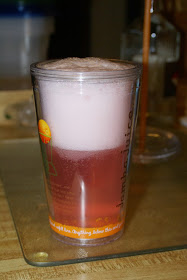If you're unfamiliar with rhubarb, you should know that the leaves contain enough oxalic acid to produce toxic effects. Don't eat the leaves. The stalks also contain oxalic acid, but in lower amounts, so you can munch away at them, although you might not want to eat a whole garden in one sitting. Interestingly, oxalic acid (in the form of calcium oxalate crystals) is also responsible for the toxicity of taro, the dietary staple of a number of Polynesian cultures.
 Rhubarb Syrup
Rhubarb Syrup
Rhubarb (I used about 4 stalks)
Sugar (I used about 3/4 C)
Water
Clean the rhubarb, discard any icky or dried out ends (I find that by the time I get rhubarb home from the grocery store, the ends are a little shrivel-y). Chop it into chunks. This works best with a large and sharp knife. Rhubarb can be surprisingly difficult to slice through. Toss the rhubarb into a pot, and cover with water. Dump in sugar (I do this rather indiscriminately) until you start seeing an accumulation of it that doesn't seem inclined to dissolve. Turn on the heat, and bring the whole mess to a boil. Reduce the heat and let it simmer about half an hour or so, until the rhubarb is tender, and the liquid has begun to thicken (it is a syrup!). Taste test to make sure it is sufficiently sweet. Simmer longer for thicker syrup.

Strain the mixture into a container. Use a sieve, pushing the rhubarb around to increase the amount of syrup yielded. Set aside the rhubarb, too. It makes a delicious ice cream topping!
My favorite thing to do with rhubarb syrup is make rhubarb soda-- just put a few tablespoons of syrup in the bottom of a glass and add soda water. The syrup is also great in cocktails or lemonade, and if you make it thick (I don't usually), it would probably be pretty good on pancakes or waffles. I'm thinking I want to make a poundcake and soak it in the syrup, actually-- it won't be quite that simple, because that would ruin the texture (soggy poundcake... not so much). When I get that figured out, I'll be sure to post it!
 Rhubarb Syrup
Rhubarb SyrupRhubarb (I used about 4 stalks)
Sugar (I used about 3/4 C)
Water
Clean the rhubarb, discard any icky or dried out ends (I find that by the time I get rhubarb home from the grocery store, the ends are a little shrivel-y). Chop it into chunks. This works best with a large and sharp knife. Rhubarb can be surprisingly difficult to slice through. Toss the rhubarb into a pot, and cover with water. Dump in sugar (I do this rather indiscriminately) until you start seeing an accumulation of it that doesn't seem inclined to dissolve. Turn on the heat, and bring the whole mess to a boil. Reduce the heat and let it simmer about half an hour or so, until the rhubarb is tender, and the liquid has begun to thicken (it is a syrup!). Taste test to make sure it is sufficiently sweet. Simmer longer for thicker syrup.

Strain the mixture into a container. Use a sieve, pushing the rhubarb around to increase the amount of syrup yielded. Set aside the rhubarb, too. It makes a delicious ice cream topping!
My favorite thing to do with rhubarb syrup is make rhubarb soda-- just put a few tablespoons of syrup in the bottom of a glass and add soda water. The syrup is also great in cocktails or lemonade, and if you make it thick (I don't usually), it would probably be pretty good on pancakes or waffles. I'm thinking I want to make a poundcake and soak it in the syrup, actually-- it won't be quite that simple, because that would ruin the texture (soggy poundcake... not so much). When I get that figured out, I'll be sure to post it!










